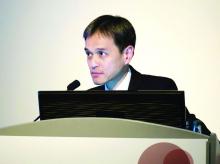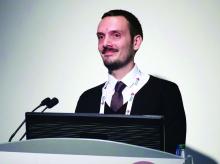GLASGOW – APL-2, a complement factor 3 (C3) inhibitor, may be a future treatment option for paroxysmal nocturnal hemoglobinuria (PNH) and autoimmune hemolytic anemia (AIHA), according to investigators from two separate studies.
Early results from the phase 1b PADDOCK trial for PNH and the phase 2 PLAUDIT trial for AIHA showed that APL-2 significantly increased hemoglobin levels, with additional improvements reported in lactate dehydrogenase (LDH), absolute reticulocyte count, and bilirubin. The findings were presented at the annual meeting of the British Society for Haematology.
By blocking C3, APL-2 acts further upstream than approved C5 inhibitors eculizumab and ravulizumab, thereby controlling extravascular hemolysis in addition to intravascular hemolysis. This broader level of control is needed for some patients, the investigators said, such as those with PNH who have inadequate responses to C5 inhibition.
PNH
“Even in PNH patients treated with eculizumab, up to 70% may have suboptimal hemoglobin responses and about 30% may still require blood transfusions,” said lead author of the PADDOCK trial, Raymond Wong, MD, of the Prince of Wales Hospital in Hong Kong.
PNH patients included in the open-label, dose-escalation PADDOCK study had greater than 10% white blood cell clones, LDH that was at least twice the upper limit of normal, at least one transfusion within the past year, a platelet count below 30,000/mm3, and an absolute neutrophil count greater than 500 x 109/L.
Dr. Wong described experiences with a cohort of 20 patients who received 270 mg APL-2 subcutaneously daily for at least 28 days, with the option to continue treatment for up to 2 years thereafter, if desired.
From these 20 patients, 2 patients completed the initial 28-day period but did not elect to continue and 2 patients withdrew because of adverse events (ovarian cancer and severe aplastic anemia), leaving 16 patients in the present analysis. Before treatment, these individuals were transfusion dependent, with an average transfusion rate of 8.7 transfusions per year.
Results showed that mean hemoglobin increased from 8.0 g/dL at baseline to 10.8 g/dL at day 29 and 12.2 g/dL at day 85. LDH dropped 900%, from 2,416 U/L (9 times the upper limit of normal) to 271 U/L (0.9 times the upper limit of normal). Absolute reticulocyte count and bilirubin also normalized.
Overall, these improvements led to a meaningful clinical impact, Dr. Wong said, with fatigue scores improving and most patients becoming transfusion independent on maintenance therapy, with the exception of one patient who developed severe aplastic anemia after 1 year. No significant infections or thromboses occurred.
When asked where APL-2 might fit in with current treatment paradigm, Dr. Wong said that multiple applications for PNH are being investigated, including first-line therapy and after failure of eculizumab.
AIHA
Results from the phase 2 PLAUDIT trial, presented by Bruno Fattizzo, MD, of the University of Milan, offered a glimpse at APL-2 in a different setting: AIHA.
Eligibility required hemoglobin levels of less than 11 g/dL, signs of hemolysis, and positive direct antiglobulin test for IgG and/or complement C3.
Dr. Fattizzo discussed results from five patients with cold agglutinin disease and five patients with C3-positive warm AIHA who had received 56 days of therapy.
Among the five patients with cold agglutinin disease, mean hemoglobin increased from 8.7 g/dL to 12.1 g/dL, while patients with warm C3-positive AIHA had a mean increase from 9.3 g/dL to 11.3 g/dL. As with the PNH study, absolute reticulocyte count, LDH, and indirect bilirubin normalized across all 10 patients.
“Some of the patients included in the trial have already reached more than 48 weeks, something like 64 weeks in the study, and they are still doing well,” Dr. Fattizzo said. “So it really seems that those who are do respond really keep the response with ongoing treatment.”
Nine out of 12 patients with cold agglutinin disease (75%) and 8 out of 9 patients (89%) with warm AIHA experienced adverse events, although these were mostly grade 1 or 2 and deemed unrelated to APL-2 by the investigators.
Five grade 3 adverse events in six patients included oral squamous carcinoma, hemolytic flare, pneumonia, purpura, and acute kidney injury. Five grade 4 adverse events in two patients included high calcium, high creatinine, hypoxia, and hemolytic flare, causing these two patients to withdraw from the study. No grade 3 or 4 adverse events were considered related to APL-2.
“APL-2 appears to be well tolerated and safe,” Dr. Fattizzo said, adding that a phase 3 trial for cold agglutinin disease and C3-positive warm AIHA C3+ is planned.
Both studies are sponsored by Apellis Pharmaceuticals. Dr. Wong and his colleagues reported financial relationships with Alexion Pharmaceuticals, Apellis, Celgene, Janssen, and other companies. Dr. Fattizzo reported having no conflicts of interest.



